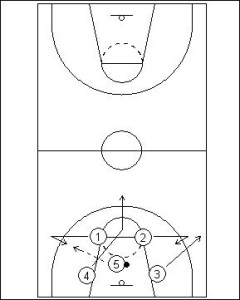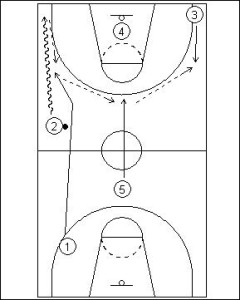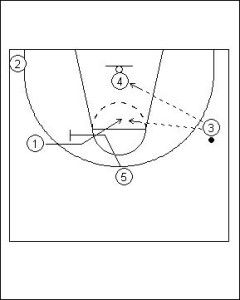Primary Transition: Two Guard Sideline Push
A Primary Transition is the name given to the structured phase in a team’s offense that leads from one end of the floor to the other. The Two Guard Sideline Push play moves the ball down the sideline through a team’s strongest ball handlers. This is also achieved while also building a strong spread from the transition down the middle and opposite wing lanes on the court.
The Two Guard Sideline Push takes advantage of your teams guards handling the ball in the danger areas of the full court. The ball is released from the Point or Shooting Guards hands only once the ball is in the frontcourt when the play is run in its regular progression. Of course, the ball can be reversed and progressed through several options down the middle or opposite wing of the court. This makes the Two Guard Sideline Push flexible and useful as a press breaker option.
The underpinning concept with all primary transition offences is for players to run the floor hard. For the most part the difference between a fast break and primary transition is that the latter is often following a score made by the opposition. This often means the use of a primary transition will need to beat all five defenders as it progresses the ball from one end of the floor to the other. As a result, the offensive players involved in the transition must make their movement into the positions stipulated by the primary transition a foot race that they cannot loose.
The pivotal player within the Two Guard Sideline Push primary transition is the guard moving to the halfway line. This player must receive the pass while on the run and with enough time to be able to change direction into a speed dribble to commence the attack on the offensive teams basket. A pass too late will result in the guard running out of bounds or even the ball being passed behind the moving player which can easily result in turnover.

Guards (One and Two) create leads for the outlet pass.
Once the ball is secured in the rebound the strong side forward aggressively runs the floor (Four).
The weak side forward moves into the outside running lane (Three).

The strong side guard (One) squares up to the front court looking for passing options.
The Weak side guard cuts aggressively to the strong side outside lane.
Four (4) continues to run floor hard until in front of basket.
Three (3) sprints to the weak side long corner.
Five (5) trails the movement as a pressure release option.
One (1) makes a pass to Two (2) down the sideline.
Two (2) reverse pivots to square up towards basket.

Two (2) dribbles into strong side long corner.
Four (4) moves into a scoring position as the ball is advanced into the long corner.
Three (3) bounces back towards the foul line extended on the weak side.
One (1) fills into the foul line extend position on the strong side.
Five (5) moves into the point position.
Ball reversal is created through quick passing between Two (2), One (1) and Five (5) onto Three (3).

Secondary Transition Option:
Three (3) receives the pass the squares up to the basket looking for scoring opportunities.
After making the pass Five (5) screens away from the ball for One (1).
One (1) makes a read off the screen working into a shooting position in the keyway.
After setting the screen Five (5) rolls to the basket creating two man game scoring option with One (1).







